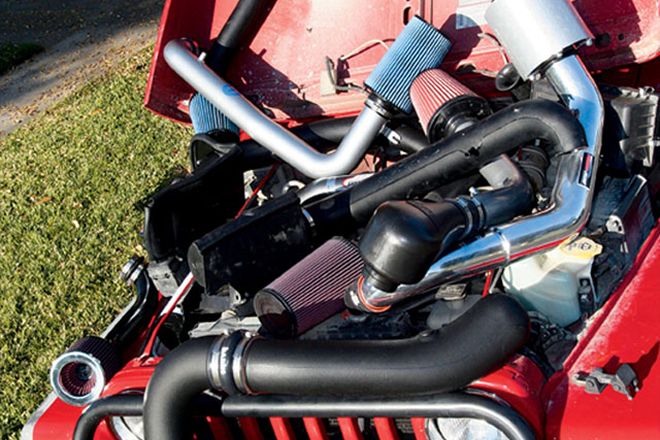
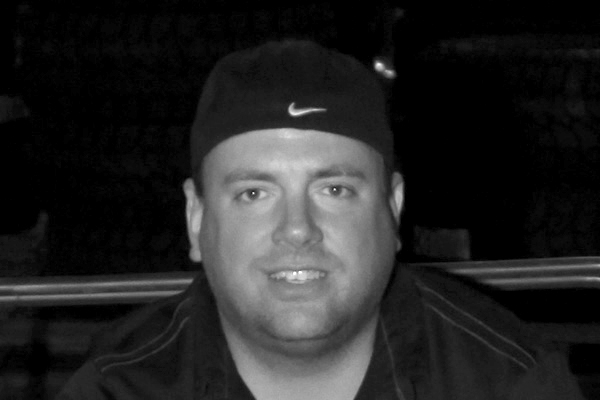 Pete Trasborg
Brand Manager, Jp
Pete Trasborg
Brand Manager, Jp
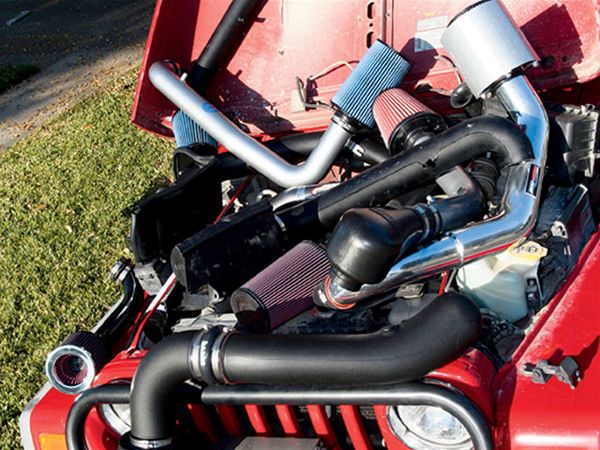
After we wrote our story "a Day On The Dyno" in the June '07 issue, we decided that we weren't quite happy with how we did things.
If some testing is good, then more testing must be better, so we contacted as many coldair, high-flow intake manufacturers as we could to take our testing to the next level.
The test mule, once again, was our '01 Wrangler. This time around, we had 138,000 miles on it, with a stock engine, transmission and transfer case, a brand new JE reel rear driveshaft, 4.56 gears, a rear Detroit Trutrac, a Gibson cat-back exhaust system, and 315/75r16 (35-inch) pro Comp Extreme aTs.
Sometime between the last test and this one, we had formed a working theory that it wasn't so much the air filter as the air tube that makes the power in these kits. With most, if not all, aftermarket air intakes, the air filter itself can flow more air than the Jeep can use. Sure, there are varying degrees of restriction from one filter to the next, but on a stock 4.0l engine we just aren't convinced that a significant result will be seen at the wheels from the air filter alone.
For our money, our butt-dyno can't tell the difference if one Jeep has 2 more horsepower than another, and really, any number of things can lead up to a variance of 5 horsepower or lb-ft of torque. Now, 10 horsepower is another story, and we think that is significant.
For the testing this time around, we ran each kit for three dyno pulls using a rear wheel dynameter. in our results listing, we have taken an average of the three maximum horsepower and three maximum torque numbersfor a quick comparison. look, before you fire up the hate-mail generators, we know that peak horsepower and torque numbers aren't going to tell the whole story, but all the intakes we tested were very close and improved drivability over stock. For the whole power story, check out jpmagazine.com, where you will find the dyno pulls in their entirety, as well as a video of each pull.
Of course, we put the stock intake, with a new filter in it on for a baseline, but then we also went ahead and pulled off all of the stock filtration just to see what we'd get power-wise. The summary of our testing can be found below, including the stock and stripped-ofeverything tests.
Below, we give a brief description of our impressions of the kit, list the Manufacturer's Suggested retail price, and rate the difficulty of the installation from a low of 1 (most difficult) to a high of 10 (easy as pie). if the install was a slam dunk, with no hammers required, went quickly, and didn't have a million parts, it got a 10; if we hit snags, or it had a ton of parts, and thus took longer, the install rating started going down. We note the type of filtering element below in case you've got a preference there. We provide a quick view of the average max power produced with each kit and list a few pros and cons of each.
At the end of the day, we still feel that we should be buying these intake kits based on how well they filter, how easy they install, how it compliments the Jeep, which one fits our budget, or simply which company we like the best. They are all great kits, and any pros and cons we list are really minimal grievances with them that wouldn't stop us from buying any of these kits in the future.
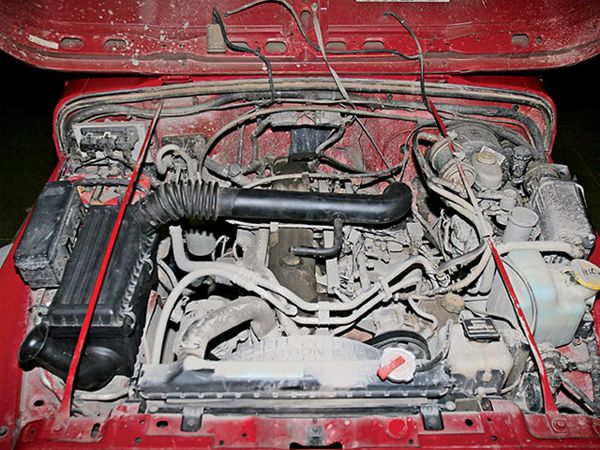
First, we ran the stock intake and filter setup. it is made of plastic and rubber, with a few hose clamps to hold it all together, and we had no problems installing it because it was already there.
Msrp: $21,000 as tested (came attached to '01 Wrangler)
Install 1-10: 10 (bolted on just like stock)
Filtering Element: paper and foam
Average Peak Torque:188 lb-ft
Average Peak Horsepower:142.3 hp
Pros:
installs great
filters really well
high resistance to water intrusion into engine
Cons:
paper element falls apart when wet
doesn't flow that well
it is a stock part.
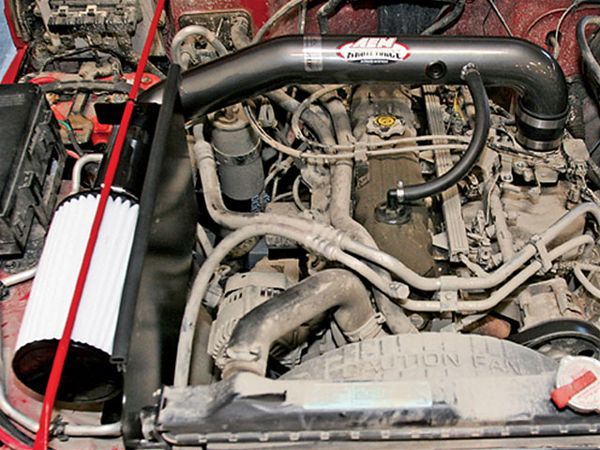
The AEM kit is one of the few that included a Carb exemption sticker. For '05 and '06, Jeep added an air sensor to the intake air stream. So, intake kits for those years need to have an additional hole in the tube. AEM includes the hole and a block-off grommet to plug it if you've got an earlier Jeep. however, on our kit, we felt the plug was too loose, as it wiggled in the hole after it was installed. So, we Rtv'd it in place.
Msrp: $362.71
Install 1-10: 8
Filtering Element: Synthetic Dry filter
Average Peak Torque: 198.4 Lb-Ft
Average Peak Horsepower: 155.1 Hp
Pros:
no oiling needed-easy cleaning in a bucket of water or smacking on a bumper
among the best filtration of aftermarket conical filters
all parts needed for install were included, with extras to boot
Cons:
With the throttle body spacer, it can be more difficult to install than some others
halfhearted attempt at separating ambient engine air from the intake (the area between the under hood fuse box and the filter is largely open
we'd stain the bright-white filter on the first off road trip we took.
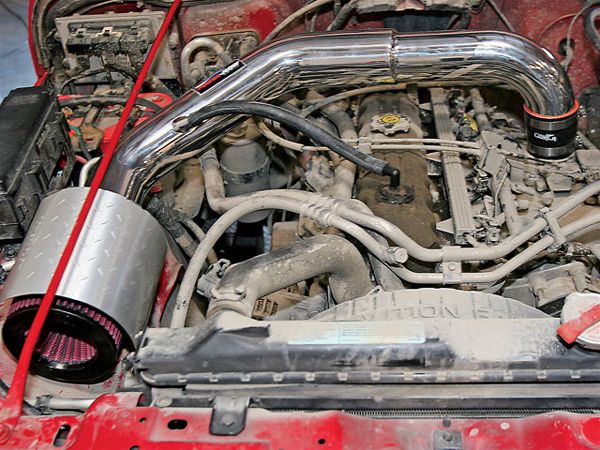
Just to see, we then removed everything. Sure, we gained 4 hp and 8 lb-ft, but the first time we drove the Jeep on the road we were likely to kill the engine. Also, as you'll see, most of the intake kits made better power than we did with just the bare throttle body.
Msrp: -$27.00 + shipping (what we could sell it for on ebay)
Install 1-10: 10 (maybe the easiest one to put on the Jeep)
Filtering Element: None whatsoever
Average Peak Torque: 192.3 Lb-Ft
Average Peak Horsepower: 150.1 Hp
Pros:
installs great
unclutters engine compartment
we proved some kind of tube is needed for best power
Cons:
No filter means lack of engine longevity
very easy for water to get into the Engine
manifold burritos will be sucked into the engine
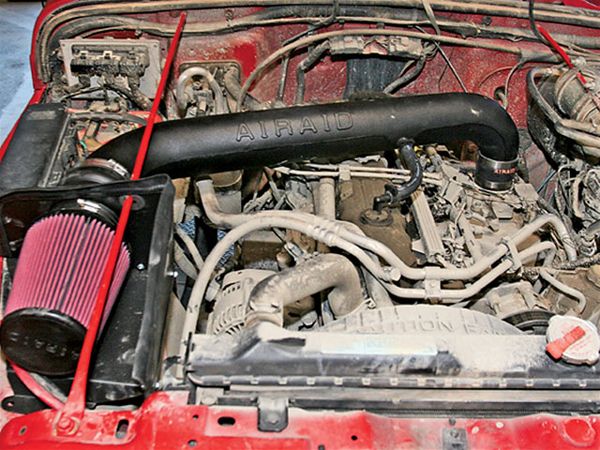
Once again, we had problems with the winch cables and the cold-air metal housing. also, the metal housing comes as two parts. Ours was slightly bent, and we had a heck of a time getting the tiny screws in place with our big, meat-hook hands. Once we got the cold-air setup dialed in, we were fine. The opening for the air filter is huge-about 5 inches-and has a nice gradual taper down to the size of the throttle body opening.
Msrp: $399.82
Install 1-10: 6
Filtering Element: Cotton Gauze
Average Peak Torque: 200.9 Lb-Ft
Average Peak Horsepower: 154.0 Hp
Pros:
Gradual taper on intake tube
Good power numbers
unique design has filter bolting to coldair mount on one side, and tube to the other. Tube doesn't actually bolt to filter.
Cons:
Child-sized screws for cold-air housing
requires removal of valve cover bolt for a brace
requires removal of underhood fuse block, fuse block bolt, radiator bolt-in rust areas, this could be a problem.
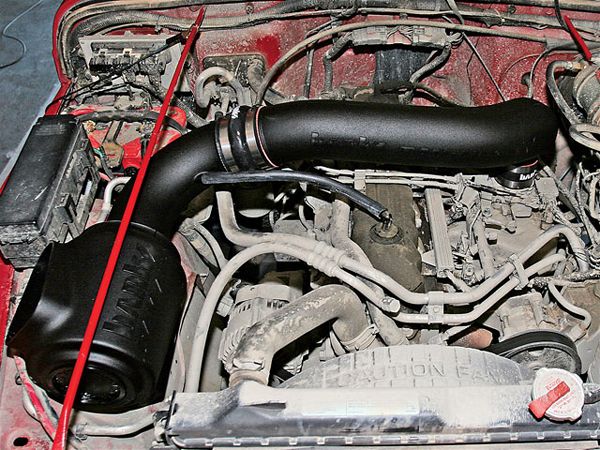
The unique plastic housing gives us high hopes for keeping water and junk thrown by the fan out of the filter. The kit installed like a dream with all holes lining up the way they should. It has nice hose clamps for the intake that prevent pinching, but for the pCV, the kit has the hardto- handle spring-style clamps.
Msrp: $443.33
Install 1-10: 10
Filtering Element: Cotton Gauze
Average Peak Torque: 197.2 Lb-Ft
Average Peak Horsepower: 152.7 Hp
Pros:
Dirt repelling housing l
Large diameter intake tube with smooth curves and no rough edges
Nice silicone couplers
Cons:
Reuse of factory bolts required (could be a problem in rust areas)
Wear eye protection when installing clamps for pCV hose
No drain in unique housing could lead to pooling of water around air filter
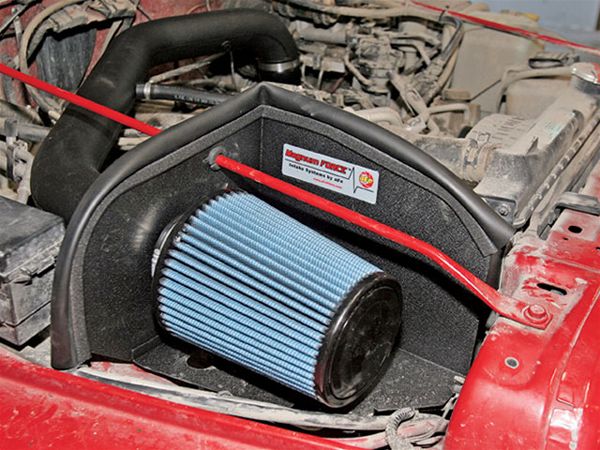
The silicone parts included with the aFE kit were nice and supple, like a high-end scuba diving mask, and we had no problems installing them. This kit also had a CarB number included with it. The one-piece plastic intake tube made the install a breeze
Msrp: $311.12
Install 1-10: 9
Filtering Element: Cotton Gauze
Average Peak Torque: 199.3 Lb-Ft
Average Peak Horsepower: 153.0 Hp
Pros:
Some kits didn't even include a pCV hose. With this kit, we got too much hose and had to cut it.
Supple, high-end silicone
Good separation of filter and engine bay
Cons:
Supple silicone of filter means a lot of filter vibration when running
Metal cold air housing interfered with winch cables and headlight wires.
Due to the interference, we weren't able to access one mounting hole without rerouting our winch cables

The Mopar kit bears many similarities with the aEM kit. There, we said it. Both include a throttle body spacer, both include spacers for the throttle and kick-down linkage, the intake tubes are the same diameter and dimensions, and the cold-air housings are of the same design. The Mopar kit uses a cotton gauze filter where the aEM kit uses a dry filter.
Msrp: $359.00
Install 1-10: 8
Filtering Element: Cotton Gauze
Average Peak Torque: 199.8 Lb-Ft
Average Peak Horsepower: 155.6 Hp
Pros:
Well-thought-out kit, with all the parts needed, and then some
Has factory backing. No more possibility of warranty denials thanks to intake kit.
Can get parts for it, as well as oil and cleaning kit at dealers nationwide
Cons:
With the throttle body spacer, it can be more difficult to install than others
Same issue with cold air separation as the aEM kit (large space at the area behind the filter near the under hood fuse block)
Included hose clamp doesn't fit pCV hose at the intake tube

The kit from injen includes an interesting stepped intake tube and unique diamondplate- styled shield- presumably to keep water, mud, and dirt off the filter. The shield will protect it from debris thrown from the fan. This kit lost points on the install because it didn't include a pCV hose (which means we had to drive to get one), and because it did not include a block-off plug where that air sensor goes in the '05 and '06 Jeeps. We had to steal a block-off from another kit for the dyno pulls.
Msrp: $360.00
Install 1-10: 7
Filtering Element: Cotton Gauze
Average Peak Torque: 197.4 Lb-Ft
Average Peak Horsepower:152.4 Hp
Pros:
Unique debris shield for filter
Nice silicone coupler at throttle body
Unique stepped intake tube design
Cons:
No pCV hose provided, but easy to find
Shield won't be enough for deep water and mud, where the fan throws a lot of stuff. Good for light debris though
No block-off plug for '04 and earlier models-not so easy to find.
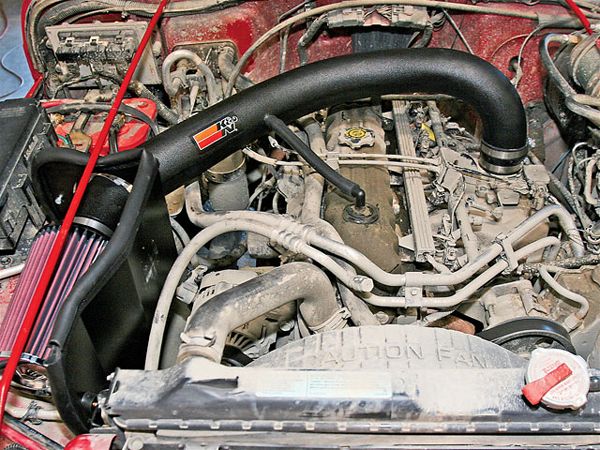
The k&N Fipk could very well be the grandaddy of all these kits. We remember the introduction of the Fipk years ago, and to the untrained eye, it looks as though not much has changed over the years. it includes a CarB exemption sticker, quality plastic intake tube, and highflow k&N conical filter.
Msrp: $385.84
Install 1-10: 9
Filtering Element: Cotton Gauze
Average Peak Torque:198.5 Lb-Ft
Average Peak Horsepower:153.8 Hp
Pros:
Million mile warranty on filter
50 state legal
Smooth intake tube curvature
Cons:
Cold air housing interferes slightly with aC line-trimming of housing required
Cold-air housing doesn't completely separate filter from hot under hood air
Bracket at radiator hard to get tools on.
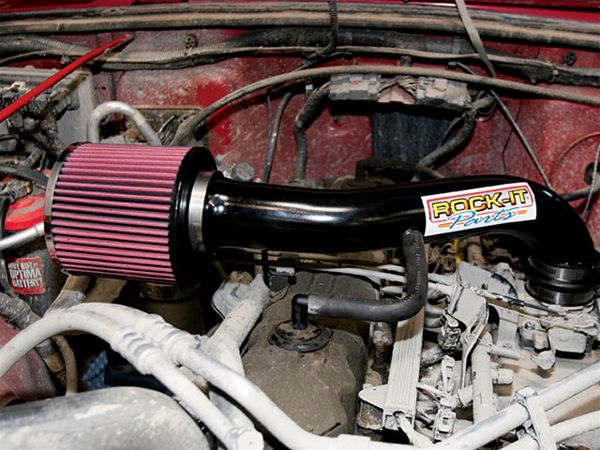
If you end up with this kit and ever bust a driveshaft, you could likely use the tube off this kit, some coat hanger, and some battery cables to weld it together and get off the trail. The construction of it is really that stout. also, it installs very easily, the price is reasonable, and it puts up some good power numbers too.
Msrp: $119.95
Install 1-10: 10
Filtering Element: Cotton Gauze
Average Peak Torque: 197.3 Lb-Ft
Average Peak Horsepower: 152.3 Hp
Pros:
Spare driveshaft under the hood
No need to flex constantly between engine and body, entirely mounted on top of the engine.
Air filter above the engine could save it from fan-flung debris
Cons:
No filter shield could pose a problem in deep water crossings.
A larger-diameter tube might make more power
No Carb number could mean an annual uninstall for emissions testing reasons.
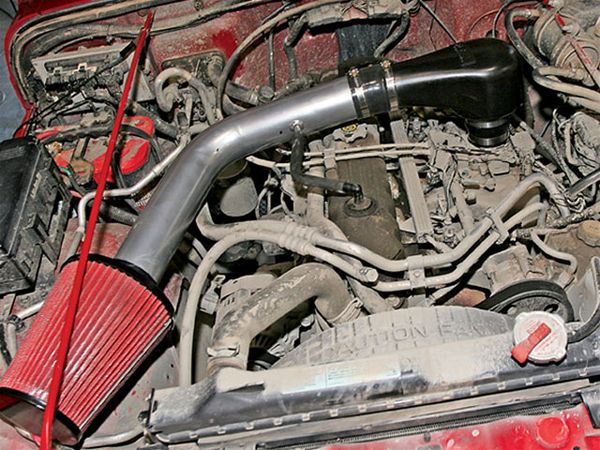
We had no problems installing this kit, and we like the air horn design. also, you could use the metal tube as a personal protection device in a pinch. The air horn seals to the throttle body with a small rubber band and a clamp. We would prefer a true silicone coupler for a tighter seal.
Msrp: $180.00
Install 1-10: 9
Filtering Element: Cotton Gauze
Average Peak Torque: 197.9 Lb-Ft
Average Peak Horsepower: 151.7 Hp
Pros:
Awesome price point-great bang for your buck
Heavy-duty air tube good for both insulation of the incoming air charge and personal protection.
Neat air horn design could lend itself to snorkel and other modifications
Cons:
Intake seal not as robust as the couplers on other kits
Required to reuse factory bolts (could be a problem in rust areas)
No shield of any sort to protect filter from flying debris and water.
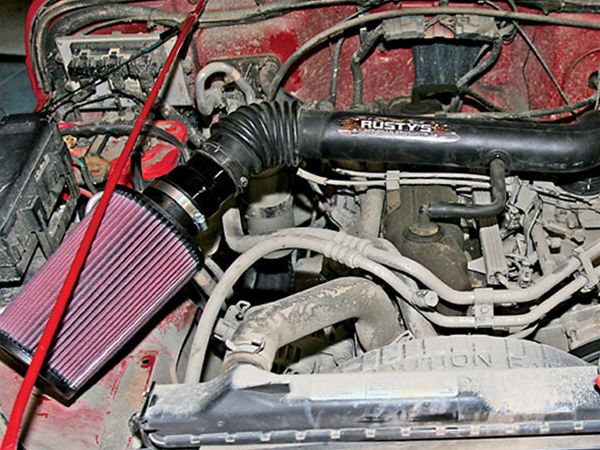
Rusty's Off road takes a very simple approach to adding power with the air intake system. The company simply uses the stock tube, and sells an adapter for a conical filter. We opted for the larger 6x9-inch filter for our testing purposes. install is as easy as removing the stock air filter box.
Msrp: $72.90
Install 1-10: 10
Filtering Element: Cotton Gauze (k&N filter)
Average Peak Torque: 191.6 Lb-Ft
Average Peak Horsepower: 146.9 Hp
Pros:
Most reasonable price point gets you in the door if the budget is tight. upgrade the tube later
Simplest install of the bunch
Choice of available filters to suit your budget and wheeling style or environment
Cons:
Retention of the stock intake tube hinders power production.
Unsupported filter tends to vibrate at a certain engine rpM. This could be unique to the big filter we chose
No filter shield leaves it vulnerable to all sorts of dirt and moisture when wheeling.